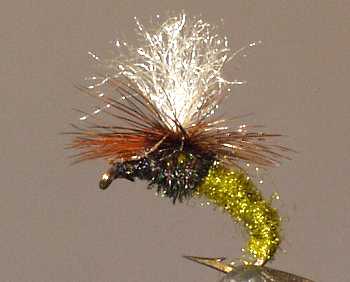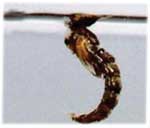Olive Klinkhammer Emerging Caddis Nymph
The Olive Klinkhammer emerging caddis nymph dry fly pattern was designed by Dutch angler Hans Van Klinken and is a wonderful fly to use when there is a hatch of Pond olives or caddis.

KLINKHAMMER EMERGER FLY PATTERNS. Hook size 12 14 16 - $US each
I always look forward to the month of May with the chance of some good days where you can go fly fishing in your shirt sleeves. The March winds have gone and so have the April showers, but you know what the weather can be like. It sometimes does not play by the rules. The sighting of the first hatches of olives in the UK on large stillwaters like lakes and reservoirs is normally the sign that summer has arrived. But of course if you have been river fishing you would already have seen the first hatches as early as February or March
The Pond Olive (Cloeon dipterum) is normally the first of all the Stillwater dayflies to hatch. They are part of the Ephemeroptera family. The nymphs can be observed darting up from the weeds and other vegetation on the bottom to rest momentarily beneath the surface in clear water conditions from April onwards. If conditions are right the skin along the back of the emerging pupa splits to allow the young adult dun to force its way up onto the water surface and erect its wings as it does so. This process can take a few minutes or a few seconds. The new air breathing insect will rest for a few minutes and then fly off to nearby vegetation. It will have an olive body that that becomes slightly amber near the tail and dark bluish wings.

Females rest in the vegetation whilst the males swam together until the females join the swarm and mate in flight. The females return to the bushes and rest for up to ten days until their eggs are fully developed. They then fly out onto the water and lay their eggs onto the surface. What is really amazing is that these eggs hatch immediately on contact with the water. This is unique among British day flies. The tiny nymphs swim away, darting for cover amongst the bottom vegetation. The exhausted spent female is left flapping around on the surface until it gives up the fight and drowns. It is then that many are eaten by hungry trout.
This insect species is capable of having between two to three generations between May and October. All stages of this insect’s life cycle offer a fly fishing opportunity if you are armed with the right fishing fly. The last generation of nymphs will normally develop over the winter ready to repeat the cycle all over again next May. Pond Olive adults may survive for a few weeks unlike its relative the true mayfly, Ephemera Danica.
The dry fly fisherman has to present a fly that looks similar to the natural mayflies that are hatching on the water surface all around them. This includes colour and size. There are a number of different mayflies that have the same characteristics and can therefore be imitated with just a few fly patterns. I am talking about the group of flies commonly known as olives. They can be found in a great variety of habitats at different times of the year. They are important flies to the stillwater fisherman as well as the river angler. You need to have olive dry fly patterns in your fly box to deal with these hatches.
There is one of those horrible Latin names that is given to the insect family that includes the olives. It is the order of Ephemeroptera. I can’t pronounce it. Why can’t they use simple language to give these insects names like us fishermen? They range from the olive upright, Rhithrogena semicolorata to the pond olive, Cloeon dipterum, through to the blue-winged olive, Ephemerella ignita and to the big fellow the large dark olive, Baetis rhodani.
So many entomology books get hung up with the exact identification of each sub species. Who cares! All you need to know is that it is an olive and that you have a fly in your tackle bag that can imitate it. You need to arm yourself with different styles of olive patterns. Often I have covered a rising trout fully expecting a good take during an olive hatch when the fly is refused. It wasn’t the size or the colour that I had got wrong. Maybe that artificial fly type was not sending out the right triggers.
I was on a fishing trip exploring the rivers of the Welsh boarders. On one particular morning the sun decided to come out, which can be a rare occurrence in Wales. It was still quite a cool morning but the warmth of the sun’s rays had the effect of signaling to all the Grannom nymphs in the river Avon that it was time to hatch. I fished a team of three flies with a black Klinkhammer on the surface and a selection of gold ribbed hare’s ear nymphs on droppers. I cast up stream and let them dead drift over the feeding zone. I hooked into three brown trout in the first hour, all taking the Klinkhammer.
I returned to the same spot in the evening and noticed some females landing on the water to lay eggs. These must have come off the water a couple of days ago. The female Grammon’s eggs mature over a couple of days after mating. She returns to the water and dips her dark green egg sac through the surface film before extruding them. Once the egg sac is empty she falls to the water surface exhausted happy in the knowledge that her life’s goal has been completed. This is when she becomes fish food. In the afternoon I use an olive klinkhammer to match the physical features of the egg laying female.
I caught a few fish over the 1 ½lb weight but most of them were under 1lb. they were all beautiful fin perfect wild trout. After an hour I noticed a larger fish quietly rising to investigate my olive Klinkhammer. It looked like a chub. After several abortive casts the fish gently sipped my Klinkhammer and judging by the chub like steady pull into the depths, this was surly going to be one of those large slabs of bronze. Several minutes later with the fish now back up on the surface, I was very pleasantly surprised to see a magnificent 3 ¼lb trout which was quickly released so he might fight another day.
LINKEDIN COMMENT
While doing some research as a volunteer on a local lake I spent an entire day with a retired fish biologist/entomologist from Alaska talking about fish, what they prefer in feeding practices and what works best in the presentation. One point he made totally changed my practices when working the flies. The critters crawling around/near the bottom have a food value of 15-25%. Casings are not digestible and take up space for food, until they are passed, but are easy to get to and takes little effort by the fish. Once they leave the water as an adult, and only a few have mouths, most don't live over 72 hours, then fall back to the surface, they are only in the 5-7% food value range. Most of the time the fish only feed on those when it's a short feed season or there's a low food supply. By contrast the emerger, after it shucks its casing, is considered 90% usable food value.
The legs, wings and casing are not hardened so it is immediate, total digestion and the fish will by-pass everything for the emerger. I now fish everything, even adult dries like the simple Elk Hair Caddis, below the surface and have a pretty good record on catching. Have you ever noticed how you can swing a dry fly on a stream, with multiple mends in your line, and nothing happens until the current flow pulls the fly under the surface as you start to lift the rod and reset the fly upstream? Ever notice how on still water you can do the twitch and tweak recovery and get no action until the fly is close enough you start to pick your line up and one hits the fly then? When the fly was on the surface it was just debris floating by but, as soon as it went sub-surface with the current or casting prep, it became a struggling emerger and they just can't resist that. The Klinkhammer is an emerger fly. by Phil Hager
CUSTOMER'S COMMENT
I was staying in Ross-on-Wye on a business trip and hoped to do some trout fishing. I had spoken to local fishermen and guides. They said that there was not very good trout fishing in the main river near Ross-on-Wye. It is too deep and fast. Most fly fishermen fish in the smaller tributary rivers like the river Monnow or on the nearby river Usk. You must get up early, 5am until 10am and fish very late 4pm up to 11pm to have the most success and then go be a tourist in the middle of the day or find a pub. They also said that the main action occurs just under the surface. They all recommend using emerge patterns like the Klinkhammer or Suspender midge buzzer in brown and green. I am glad they took their advice as all my trout on that trip was taken on a brown or green Klinkhammer. My friend who was using dry flies had zero fish. Kerry lyle.
FACEBOOK COMMENT
Needed to unwind at the end of the day today so I got my gear together and went for a walk to one of my favorite spots. Took a seat lit up a good cigar and waited for the festivities to begin. And begin it did the bugs began to pop on the water and the fish began to rise. I waited a bit till the fish started feeding good and picked a few targets to try out. They were taking the old Olive Klinkhammer emerger like it was their last meal. Here are few pictures of what came to the net tonight. I must say I am blessed with a great home water that just gets better with each passing year. Peter Watson, PA, USA
FACEBOOK COMMENT
Fished very narrow mountain stream today - beautiful brownies loving the klinkhammers. Bob caught more than me today so he has to buy the beers as penance. Very difficult river access and tricky wading but winkled a few trout in very shallow water. Quite cool today in the mountains 14 degrees glad we brought the fleeces !! Vara Carlson, Lancashire
Fly Fishing books

